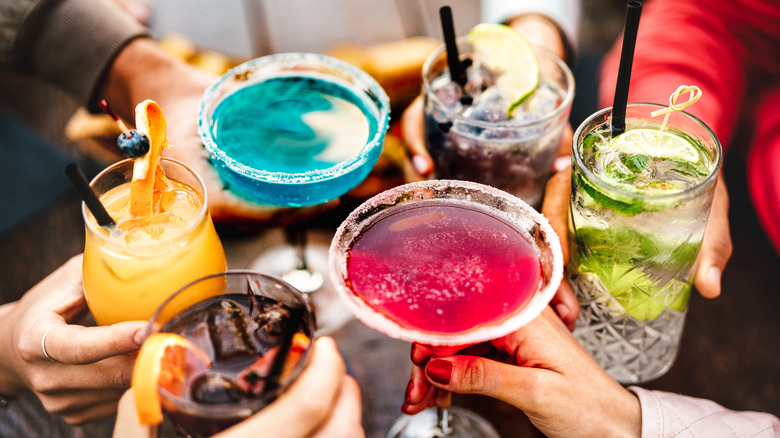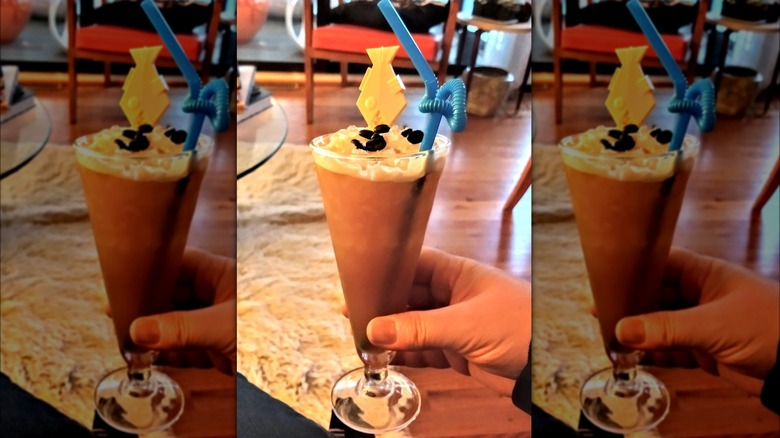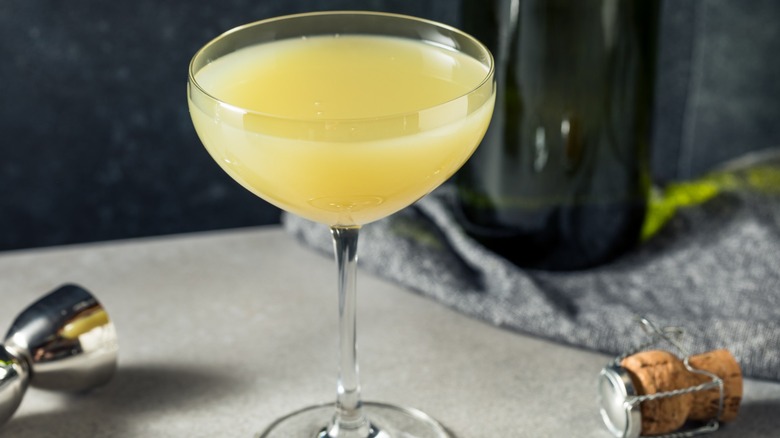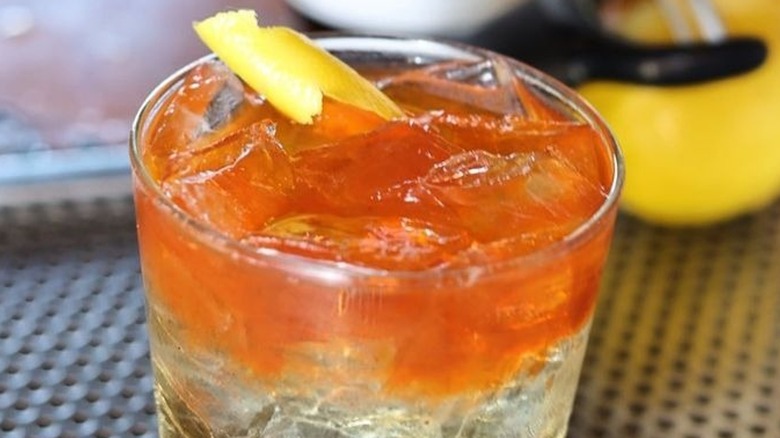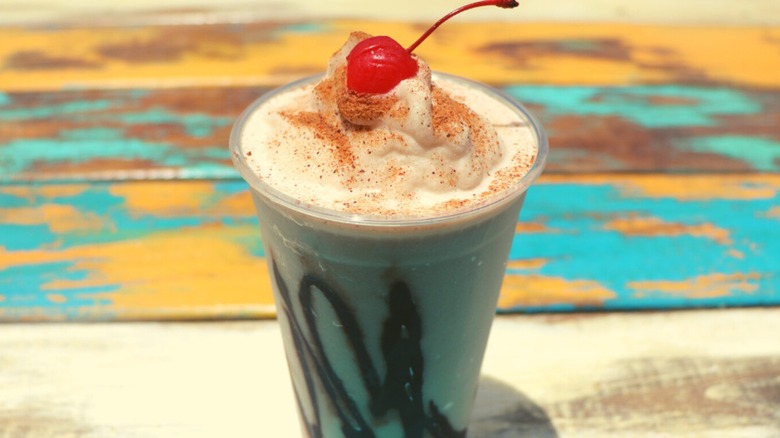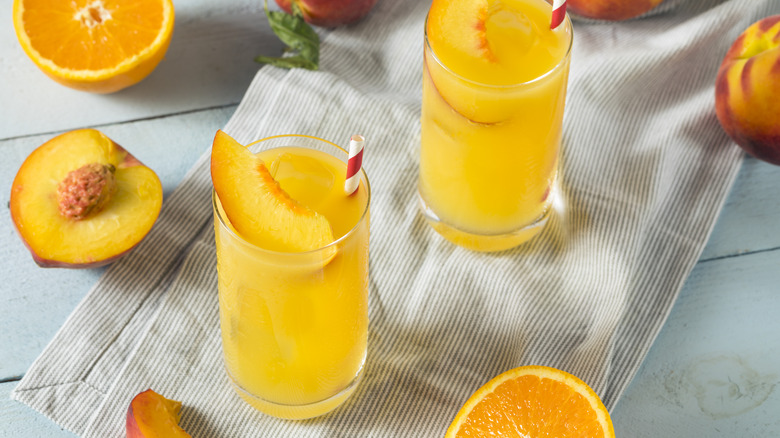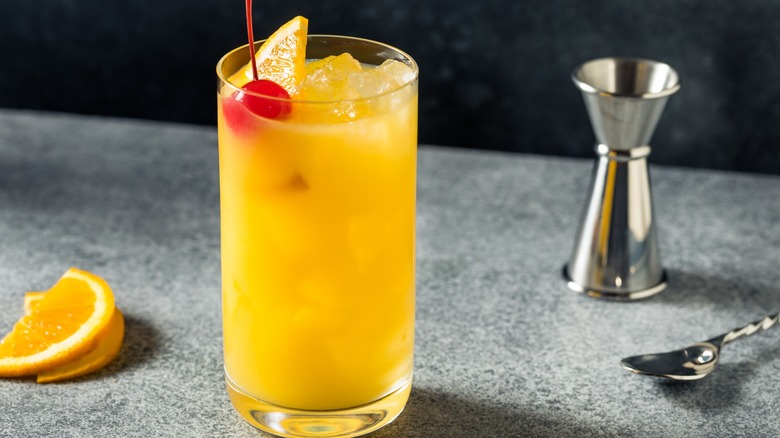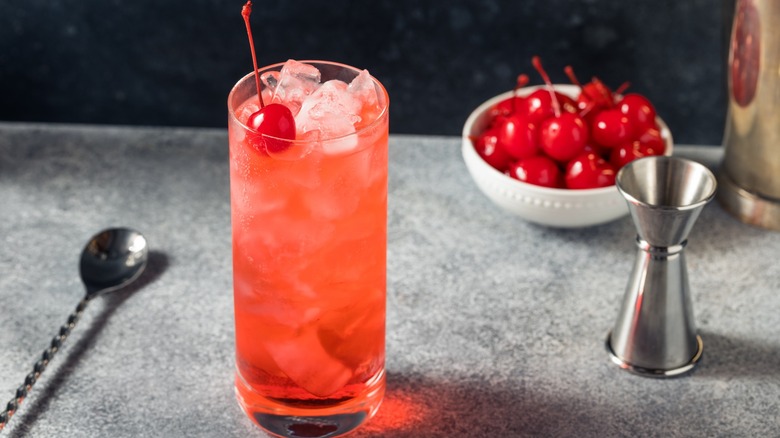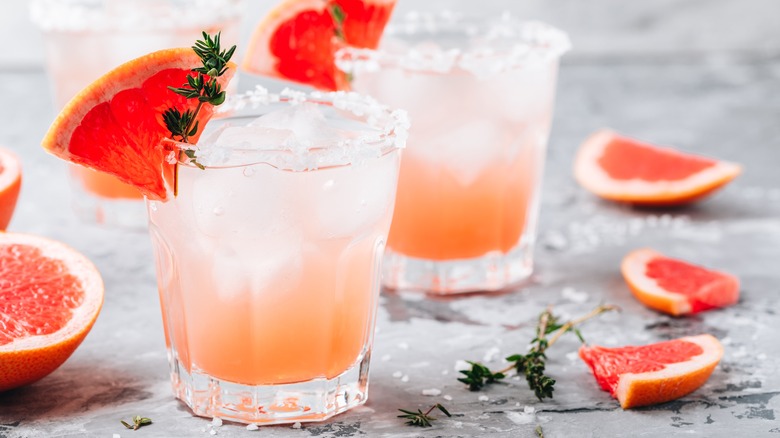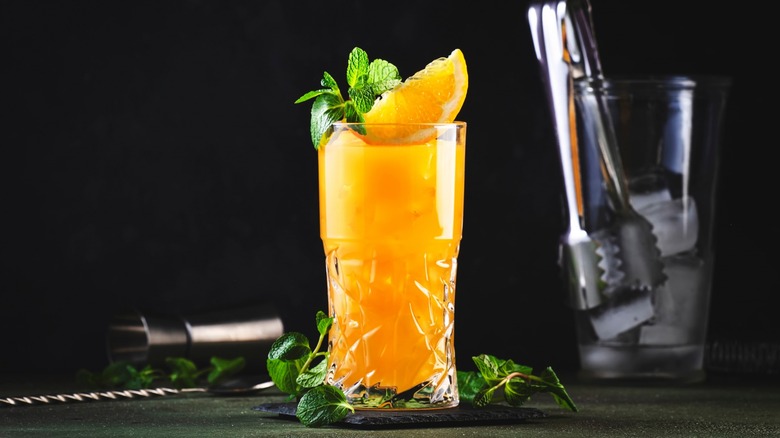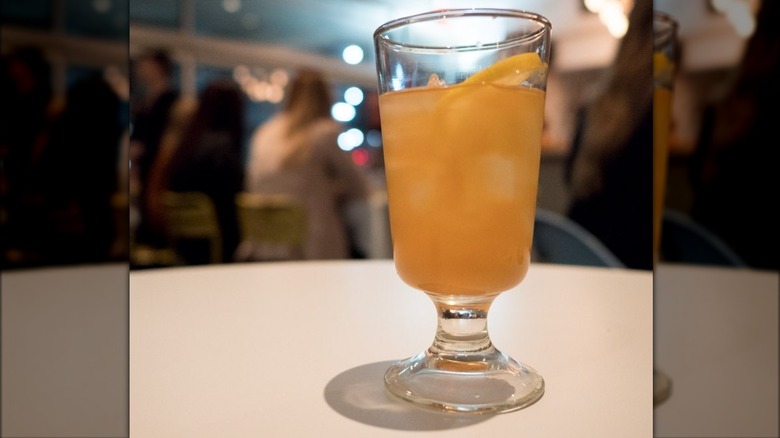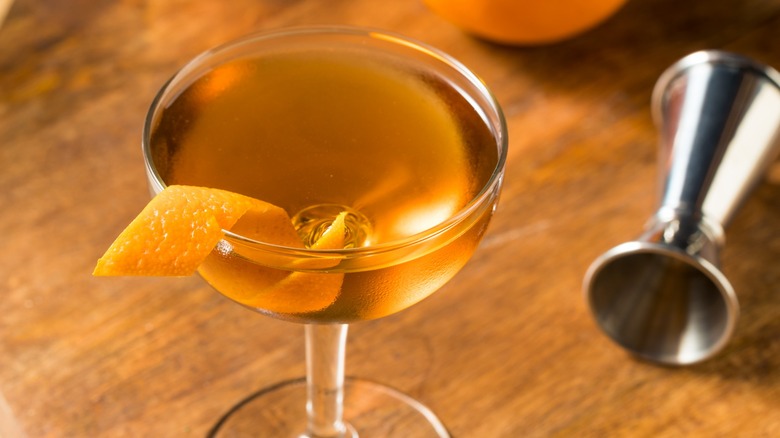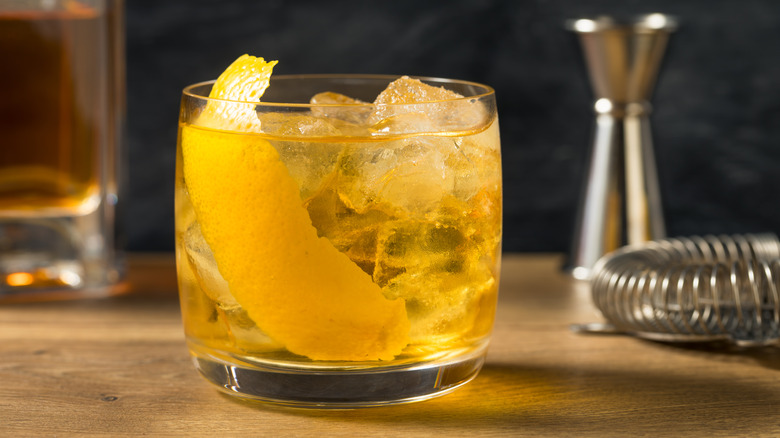The Most Bizarre Cocktail Names Since They First Started Being Poured
Not all drinks are lucky enough to have simple names like vodka and soda or rum and Coke. Reading a cocktail menu has often been a trip through the weird and the wacky. These wild monikers aren't guaranteed to even describe what's in the glass, with names either related to something culturally significant or the effects the drink might have on the drinker. And some names are chosen for the sake of getting patrons to order a drink with a provocative title just for sips and giggles.
Every bar is bound to have its own cheap yet delicious creations with bespoke names specific to the establishment. But there are several classic selections that have withstood the test of time to become standards on drink menus, each with its own strange yet recognizable title. We've created a rundown of our favorite bizarrely named cocktails that have gone spinning across bar tops since pouring beverages became a thing. If you've ever scratched your head at why it's called a Harvey Wallbanger or a Rusty Nail, well ... so have we. They may not necessarily be the best drinks to order, but they sure have some of the strangest names around.
A Lonely Island Lost in the Middle of a Foggy Sea
This powerful portable must be in the running for top spot as the cocktail with the longest name ever. A Lonely Island Lost in the Middle of a Foggy Sea showed up as a selection at Three Dots and a Dash, a celebrated Chicago tiki bar. The gloomy name belies the insouciant flavors of the ingredients, listed as a combination of pineapple and lime juice with cold brew coffee, syrup made from demerara sugar, and three different types of rum. With so many elements keeping one another company in the shaker, it's hard to think of anything about this beverage being lonely.
As for the origins of such a descriptive name, there may be no inspiration other than craft cocktail creativity. Other drink names on the Three Dots and a Dash menu include House Without a Key, Vibe Patrol, Aloha Felicia #2, and Poblano Escobar. No matter where it came from, it's fun to imagine customers trying to recite the entire name of A Lonely Island Lost in the Middle of a Foggy Sea without getting the words out of order, especially by their second or third round. Seeing it happen in real life is bound to be a riot.
Death in the Afternoon
It isn't necessarily a funeral drink, but with a name like Death in the Afternoon, maybe it should be. This darkly named concoction was created by none other than Papa himself, Ernest Hemingway (via Difford's Guide). The adventuresome writer offered his brave blend to "So Red the Nose, or Breath in the Afternoon," a collection of beverage recipes from famous writers that was published in 1935. The combination of a jigger of absinthe in a flute filled with champagne was a testament to Hemingway's toughness. Absinthe is a notoriously strong spirit, and the recommendation in the author's listing was to imbibe three to five of these dastardly drinks in one sitting.
Hemingway didn't arrive at this formula on his own. According to the note included on his page in the collection, he and three fellow sailors came up with it after a harrowing seven-hour task trying to free a fishing boat that had become stuck on a bank. Anyone with enough gumption to follow in Papa's footsteps can try this aptly named glass of danger for themselves now that absinthe has made a resurgence on the craft beverage scene. Any adventures that might occur before or after will be assumed as coincidental.
Horsefeather
The whimsical term "horse feathers" is nostalgic, vintage slang meaning nonsense or foolishness, which made it an apt title for the classic 1932 Marx Brothers movie. But the term also refers to planks used by roofers to cover wood roofs before applying asphalt shingles (via World Wide Words). It's more likely that the Horsefeather cocktail took its name from the vernacular definition rather than the construction supply, though maybe if you drink enough of them, you'll be ready to re-shingle your roof, too.
The drink itself is a mix of ginger fizz, lemon essence, rye whiskey, and Angostura bitters. Apparently, the formula for the Horsefeather is a variant of another funnily named drink — the Horse's Neck – itself a mix of bourbon, bitters, and club soda that has been around since the 1800s. In modern cocktail culture, the Horsefeather showed up in the 1990s and features ginger beer or ginger ale instead of club soda, though the mixture is similar enough to clarify the use of the word "horse" in the name as a tipsy tribute.
Dirty Monkey
If a drink features bananas, pineapple juice, and crème de coco as ingredients, choosing a name for it that makes reference to jungle critters is a pretty logical move. Calling that beverage "dirty" works best if there's booze in the glass as well, which there is — a blast of banana and coffee liqueur — in addition to a dose of rum. Give it all a pulse in the blender with ice until it's frothy and smooth, pour it into a hurricane glass, top it with a generous spritz of whipped cream and a gleaming maraschino cherry and you have what's known in the bar biz as a Dirty Monkey. Fuzzy facts surround the origins of this tropical treat, including its alternative name — the Dirty Banana. But after a few sips of these flavors, you won't care how it came to be; you'll just be happy it exists.
A mocktail version of this creamy, craveable concoction replaces the liquor with chocolate syrup and turns it into a milkshake for the whole family to enjoy. Whip up a batch sans spirits and customize each glass with a splash of rum and liqueur to accommodate all the tastes at the table.
Fuzzy Navel
If you don't know the ingredients that go into a fuzzy navel, you might get a little grossed out thinking that this popular mix is stirred up in the vicinity of a hairy belly button. Luckily, the fuzz in fuzzy navel refers to peach liqueur, and the navel refers to orange juice — the two main ingredients found in this cocktail. As related by drink historians, this juicy drink is said to have hit the cocktail scene sometime in the '80s when mixologist Ray Foley — also known as the man who started Bartender Magazine – combined peach liqueur and fresh orange juice into a sweet and sexy sip. It's also possible that liquor company DeKuyper coined the term as a way to push sales of its peach schnapps.
To concoct your own Fuzzy Navel, fill a highball glass to the halfway mark with ice and pour in equal parts peach schnapps and orange juice, about three ounces of each. This is one of the simplest and most essential drinks for every home bartender to have on hand when serving friends and family at special occasions, or just to enjoy when only something super sweet will hit the spot.
Harvey Wallbanger
Who exactly is Harvey and why is he banging on the wall? Lore abounds regarding the man who inspired his namesake's beverage. The most colorful version of events is that an award-winning bartender named Donato "Duke" Antone created the combination by adding Galliano liquor to orange juice and vodka, otherwise known as a Screwdriver. Enter Tom Harvey, a surfer who'd wandered into Duke's Blackwatch Bar where Antone was serving. Harvey had wiped out one too many times and attempted to drown his sorrows in Antone's powerful punch. Leaving the bar proved difficult, resulting in Harvey literally bouncing off the walls, earning him the title, "Harvey the Wallbanger," which transferred to the drink responsible. True or not, it's quite a tasty tale.
An expansion of the legend indicates that the drink really took off in the 1970s when a marketing director for the company that imported Galliano to the U.S. touted the Harvey Wallbanger as the brunch drink du jour. There was even a cartoon character created to advertise the mix. That's quite a heritage for a simple blend of vodka, orange juice, and the spiced vanilla essence of Galliano Autentico.
Dirty Shirley
The Dirty Shirley is an old-fashioned adult-level upgrade to familiar mocktail the Shirley Temple — a vivid pink punch-like beverage with cool cherry essence. The math on this delightful drink is easy addition: grenadine plus lemon-lime soda over ice equals an innocent Shirley. Multiply the fun with a few ounces of vodka to get a Dirty Shirley, a full-on cocktail that's at home in much more grown-up occasions than its bashful alcohol-free sister.
The Dirty Shirley became an unexpected drink darling during the pandemic, a juicy way to escape the doldrums of lockdown over a long and displeasing summer as well as an easy way for bars and restaurants to generate some income during shutdown. But how did any drink end up with the name of the curly haired kid actress from the Golden Age of Cinema? According to legend, the actress wanted a non-alcoholic drink to enjoy at dinner one night while the adults around her partook in classic cocktails. The rest is beverage history.
Salty Dog
A cocktail with a misleading name like Salty Dog calls to mind old sailors, pulling into port for their favorite quaffs after a long voyage. The less seaworthy truth is that the drink's name is a hat tip to the original recipe that gave rise to this popular variant. As it turns out, a Salty Dog is just a Greyhound – a mix of vodka and grapefruit juice – served in a glass with a salted rim. According to the experts, the Greyhound recipe appeared initially in a 1930 mixologist guide called "The Savoy Cocktail Book," written by Londoner Harry Craddock; Harper's Magazine dubbed the drink a Greyhound in 1945, based on its rumored regular enjoyment by travelers at Greyhound bus stations. This early version included gin rather than the vodka that came to be a standard in the American recipe.
If a Greyhound was already doing perfectly fine on its own, what caused the stir that gave rise to the Salty Dog? It was actor George Jessel who came up with the crystalline rim-ringer to help temper the tartness of the grapefruit juice for a more tempered taste. It's an easy drink to create at home, too.
Screwdriver
It wouldn't be wrong to think the Screwdriver was named for the digging pain drinkers experience from downing one too many of this mix. After all, a duet of orange juice and vodka is an easy drink to indulge in. The real story is even grittier than the image of the driving headache found on the other side of the buzz. In one version of the drink's origin story, American workers enjoying vodka-OJs abroad mixed the concoction with actual screwdrivers, having nothing else to use as a stir. It's a pretty gross concept, even if the generous pour of alcohol in the glass were to serve as a disinfectant. But wait ... isn't blending orange juice and vodka as simple as pouring one into the other? Why would stirring even be necessary?
Other takes on the story credit some faction of the American military with creating the first Screwdriver. Whether it was members of the Marines or the Air Force is as murky as the mixture itself. Stories usually list World War II as its point of origin. Maybe the fair measure of fun in a bizarre drink name is knowing that pretty much any and all stories of how it arose sound entirely plausible, especially after you've had a few sips.
Philadelphia Fish House Punch
No one would blame you if you saw this oddly named drink on the menu and just kept looking for something a little more appetizing. Why would anyone hoping to entice patrons to order a beverage choose the name Philadelphia Fish House Punch, then? As is true in real estate, the answer is location, location, location. The Schuylkill Fishing Company of Pennsylvania — a group of rabble rousers in early Colonial America who tried to declare themselves an independent state — created the punch recipe for their fabulous get-togethers (per Edible Jersey). The process required a ginormous tub to hold the booze, an old-timey spirit called palm arrack, plus spices, sugar, citrus juices, and an extender liquid. Those settlers sure knew how to throw a party.
The modern descendants of this rowdy organization happen to be members of the oldest fishing club in America according to Atlas Obscura, though if members' historic drinking habits are any indication, the club has survived by the skin of its teeth. Making this drink these days is far less flashy. Combining cognac, rum, and peach brandy with water, sugar, and lemon juice will fill the bowl. It doesn't have to be the size of a bathtub, though.
Hanky Panky
Fool around too much when ordering your drink, and you may end up with a little Hanky Panky on the table. The name of this beverage is so much fun to slip into conversation that you'll find yourself figuring out ways to call out the simple swig with its double-entendre name. At its truest essence, a Hanky Panky is a martini with a touch of sweetness added. Some recipes include sweet vermouth mixed with gin, Fernet-Branca, which is a form of bitters, and a splash of OJ. There's nothing too noteworthy about the ingredients, but the tale behind the beverage is a fun story that punches up the origins of the name while giving a shout-out to a pioneer of women in the mixology industry.
According to legend, the Hanky Panky was created by a bartender named Ada Coleman, a British mixer at London's Savoy Hotel. Coleman tended the American bar and, at the request of silent film star Sir Charles Hawtrey, crafted the drink as a customized tonic. It was Hawtrey who named Coleman's concoction the Hanky Panky. With that, Coleman's bizarrely named contribution to the beverage world was sealed in glass for the world to enjoy.
Rusty Nail
Did the Rusty Nail get its odd name due to the ruddy color produced by the scotch and liqueur mixed in the glass? Or was this drink actually stirred with rusty nails at some point in its storied past? Available historical accounts indicate that the Rusty Nail's ancestor was the B.I.F. — specifically, the British Industries Fair that took place in 1937. Originally, the recipe called for spirits and bitters, plus a little sweetener. After some tinkering over time, the more settled-upon mix of scotch and Drambuie became the standard, and the name Rusty Nail arose.
While the name of the beverage may be up for debate, the power of this potable is anything but questionable. Eagle-eyed readers may have noticed that there are no mixers to cut the strength of a Rusty Nail. It's simply two forms of liquor in a glass, meant to be nursed rather than guzzled. The flavor may be sweet, but the kick is firm, and even if the result is nothing even close to a round of tetanus like the name implies, drinking the colorfully named Rusty Nail should be a cautious affair.
